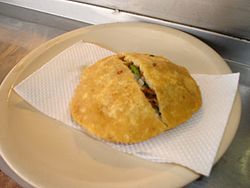This article needs additional citations for verification. (March 2013) |
A gordita (Spanish pronunciation: [ɡorˈðita]) in Mexican cuisine is a double sided tortilla made with masa and stuffed with cheese, meat, or other fillings.[1] It is similar to a pastry and to the Colombian/Venezuelan arepa. Gordita means "chubby" in Spanish. There are two main variations of this dish, one which is typically fried in a deep wok-shaped comal, consumed mostly on center and south Mexico, and another one baked on a regular comal, prepared as a thick tortilla.
 | |
| Place of origin | Mexico |
|---|---|
| Main ingredients | Corn tortillas, guisados (meat stew), salsa |
A gordita is typically prepared as a thick tortilla. The dough is most commonly made of nixtamalized corn flour, as also used for tortillas, but can also be of wheat flour, particularly in northern Mexico close to the U.S border. An old variant of corn gorditas uses masa quebrada (broken dough) where the corn meal is coarsely ground, leaving bits of broken grain. Gorditas de migas is a version in which fried pork is mixed with the dough.
After cooking, the gordita is allowed to stand to drain excess grease. Then a slit is cut into one side and the gordita is stuffed with additional ingredients. These are usually guisados (meat stew) and salsa. Variations of the gordita include fillings of pork or chicken stew, shredded beef, chicharron, nopalitos, carne al pastor, beans, cheese, rajas (sautéed strips of chile), potatoes, eggs with chorizo sausage or picadillo. Gorditas are often eaten as a midday meal and accompanied by several types of salsas.
The most common and representative variation of this dish is the "gordita de chicharrón", filled with chicharron (a spiced stew of pork rind) which is widely consumed throughout Mexico.
Regional variations
In central Mexico, gorditas commonly range from being relatively small, but bulky (about the size of a child's fist) to about the diameter of a "regular" tortilla. In northern Mexico they tend to be larger and flatter.
In most cases gorditas are shallow fried with vegetable oil in a deep comal, but they can also be deep fried, making the outside more crisp.
In Durango and others states of Northern Mexico, gorditas are commonly made from wheat flour and look like small pita breads. The dough (masa) is identical to that of a wheat flour tortilla. It is cooked on a comal with a hot piece of metal placed on top that resembles a clothes iron. The gordita fills with steam, and a small slit is cut into one side where it can be filled with guisados.
Similar dishes
- The Salvadoran dish pupusa is similar to a gordita, except completely sealed and typically served with curtido, a lightly pickled cabbage relish.
- In Venezuela and Colombia an arepa (a type of corn bread) is often served stuffed with various ingredients. It is prepared in similar way as a mexican gordita, except the final dish is smaller and slimmer. By tradition, are served with a cabbage topping.
Other gorditas
The fast food restaurant chain Taco Bell offers a wheat flour gordita that has limited similarity to gorditas as served in Mexico and is more akin to a pita bread taco.[2]
In eastern and central Mexico "gorditas de nata" (cream gordita) are consumed often as breakfast dish or snack. It is a sweet cake similar to a tiny, but extremely thick pancake made with milk cream or clotted cream, called nata in Mexico, cinnamon, sugar and white wheat flour. They are named "gordita" too, due to their appearance, similar to the original fried gordita, but their taste is sweet, not salty. Besides their appearance, this snack is not related in any way with the original one. The same flour preparation used to prepare gorditas de nata is also used to cook a flat cookie variation, which by extension it is also named "gordita", but in contrast it is thin and crispy, not thick. To differentiate it, these flat cookies are named "sugar gorditas" instead.
See also
References
- ^ Rick Bayless, JeanMarie Brownson & Deann Groen Bayless (2000). Mexico One Plate At A Time. Scribner. pp. 40–50. ISBN 0-684-84186-X.
- ^ Mark Busby (2004). The Southwest. Greenwood Publishing Group. p. 253. ISBN 9780313328053. Retrieved 6 March 2013.
External links
- Media related to Gorditas at Wikimedia Commons